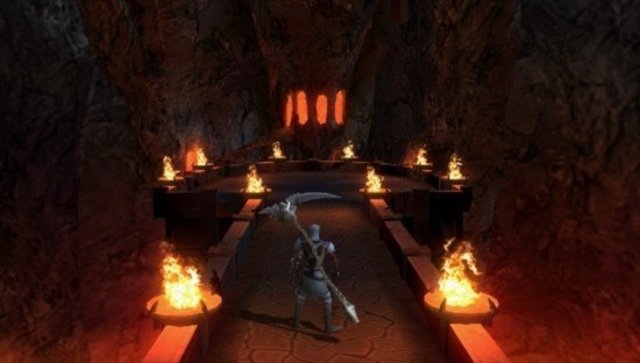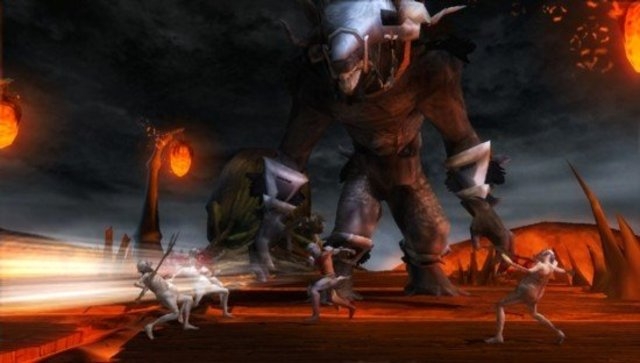
Dante's Inferno - Review
by VGChartz Staff , posted on 23 March 2010 / 5,897 ViewsBy now, it is common knowledge that just about anything is susceptible to being made into a videogame. Therefore it was only a matter of time before we were playing games based on epic poetry such as Inferno. Developed by Visceral Games, Dante’s Inferno is the re-imagining of Dante Alighieri’s influential work as a violent hack and slash game. The game bears a strong resemblance to a certain other mythological action adventure, but does that mean it lives up to the acclaim of its source material?
Dante is a soldier during the Crusades and, after executing many terrible crimes, he is confronted by Death. He survives, and after experiencing the horrors of war returns home to find both his father and his fiancée Beatrice slain. The innocent Beatrice is taken to the underworld, so Dante plummets to Hell in order to save his betrothed. His journey is not an easy one and will require him to survive the nine diabolical Circles of Hell. Listed in order they are: Limbo, Lust, Gluttony, Greed, Wrath, Heresy, Violence, Fraud and Treachery.
The combat system fuelling Dante’s descent seems well thought out, but that does not mean that it is perfect. The controls are not as tight as in the console versions and can be a bit cumbersome overall, but they get the job done. Dante’s weapon of choice is the scythe, which he wins from the Grim Reaper. Melee attacks are relegated to the same two-button scheme found in many other action games: square for swift-light attacks and triangle for stronger but slower hits. L blocks, holding L and R together while moving the analog stick evades, the directional buttons command magic and X is used for jumping and double jumping. Circle fires projectile holy crosses, the supply of which is infinite. By defeating foes, you build up the Redemption meter. Once it is filled, Dante can receive a boost in attack power if you press R1 and L together. As I alluded to above, the controls can be tricky to master. In particular, it took me a while to get the hang of countering some enemy attacks and evasion is hampered by rigid camera angles.
As you would expect, this is a violent game, featuring graphic fatalities and copious amounts of blood splatter. The grotesque enemies you encounter are all vulnerable to being ripped apart (or worse). But beyond the gore, the world of Dante’s Inferno is innately dark and miserable, filled with damned denizens at every turn. Reprising his role from the original poem is the poet Virgil, your guide through Lucifer’s dominion. The overall theme throughout is that you can be the sole emissary of divinity or be just as savage and relentless as a demon.

The range of enemies you will square off against is not as large as it could be. There are demons, gluttons, heretics, and even un-baptized babies. The variety changes as you progress through each of the nine circles. Eventually, the enemies become overly repetitive and just downright unpleasant to encounter. You are capable of stringing together attacks for formidable combos, and will unlock more of these combos as you collect souls to upgrade Dante’s abilities. This is another game that uses the notorious Quick Time Event (QTEs) system to supplement the action. Usually, these are initiated when a shoulder button icon appears onscreen. As you would expect, they are used to finish off enemies and bosses, and perform otherwise impossible feats during gameplay. This is neither the best nor the worst use of QTEs which I have encountered, but they're certainly noticeably less compelling than those found in the console version, or even in God of War Chains of Olympus.
One of the more original ideas to be found in Dante’s Inferno is the Judgment feature. You have the ability to either punish or absolve many enemies within the game. Absolving will lead to enemies ascending in an explosion of light (the timing based minigames for absolving are mysteriously absent however), while Punishment means a sadistic demise. It may not sound like much, but your decisions come with consequences. Your choice to either punish or absolve will unlock abilities down both a holy and unholy path. This system extends past just the combat, as you will come across many damned souls named Shades throughout your journey. Each Shade is based on the soul of a past mortal with some historical significance, and after reading of their sins, their fate is placed in your hands. Honestly, there is no point in being partial when it comes to these choices as the only way to get significantly stronger is to choose a path and stick with it.
Apparently, Hell contains a few puzzles, serving to break up the fighting segments that comprise most of the game. They are not overly complicated, occasionally falling back on clichés of pulling levers and rotating switches. All of the ones found in the console version are here with one peculiar but inconsequential omission. There are a few that display noticeable degrees of originality, the best of which comes early on and involves mind-bending portals. The level design is one of the biggest downfalls of Dante’s Inferno. None of it is bad per se, just forgettable. Some games prove that linearity does not impede original level design, but this is not one of them. Sure, not all of your time is spent running around killing off baddies; you’ll rappel and crawl across walls, grapple your way to certain areas and even hitch a ride atop a beast or two, but it's just not remarkable.
I maintain that this is a decent game. The inspired look of it certainly helps. The graphics are strong for a PSP title, and a surprising amount of detail from the HD version has been replicated. Unfortunately, the PSP game contains overt technical hiccups. Beyond frame rate drops, recurrent loading times, and some lacking texture work, the artists tried to make each circle of Hell look distinct, which they do to a certain extent (Greed is golden and Gluttony features a lot of disembodied mouths), but to the casual observer it all just looks like Hell. The animations are rock solid. The art direction on the enemies is striking: they certainly give off a demonic vibe, especially some bosses like Cleopatra and her strange mouths for nipples. Speaking of bosses, they too fall in the mixed realm of simply average.

It is ironic that a game about eternal damnation could have a story that feels so soulless. Obvious license with the original poem was taken but it doesn’t feel as though it was taken far enough. There is no compelling reason to care about the characters or what happens to them. Dante will encounter Lucifer and a villainous incarnation of Beatrice, but all they do is taunt him with memories of his past sins. Every now and then you will come across someone from his personal life that he has wronged, and even be forced to fight them, but considering that all of these characters are already dead, their fate is inconsequential from the player’s perspective. Nothing particularly gripping occurs until close to the end of your adventure.
The story is told through a blend of CGI, in-game, and hand drawn cutscenes. Each method looks surprisingly sharp on the PSP, but the 2D used for flashbacks is the most eye-catching. Dante’s Inferno doesn't sound bad either. The soundtrack, voice-overs and sound effects are all up to par. The appropriateness of this game’s presentation compared to the original piece is something I am not capable of determining, but I doubt it matters to most of the gamers that will play this.
In terms of raw play time, the main adventure could run anywhere from 6 to 11 hours. The game makes a strong case for at least one replay, thanks to an unlockable difficulty, plenty of collectibles, and the opportunity to venture down the path you ignored the first time around, so you can experience every ability that Dante is capable of performing. PSP owners will miss out on the Gates of Hell arena, but can unlock a digital comic book instead. There is also the absence of DLC to contend with. On the bright side, almost all of the content from the console game is here save for some bizarre instances where playable scenes are replaced by low res video using in-game graphics.
Ultimately, Dante’s Inferno follows an interesting approach, with ideas that do not fully pan out. The holy and unholy aspects make the game feel different, but much of the rest feels stale. Does it stand toe to toe with the best hack and slash action games available? No, not at all. However, there is a fair amount of amusement that you can squeeze out of this trip through Hell, if you are a fan of the genre.
VGChartz Verdict
7
Good


























